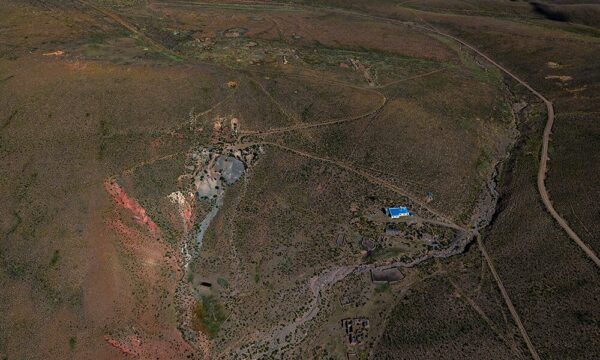Production uplift and much improved outlook for PGM prices
In a very challenging PGM price environment over recent years, Sylvania has focused
its energy on production efficiencies, development of the Thaba JV to increase the
production pipeline (and diversification into chromite) and laying the groundwork
for the development of its exploration assets, while maintaining cost discipline.
This positions the company very well to benefit from the recent upturn in the PGM
price cycle and the much improved outlook for the sector.
As discussed in our March 2025 note, Sylvania commenced a period of high capital expenditure (capex) in FY22, which reached
a peak in FY25, and after one more year of elevated spending is expected to start
moderating from FY27. A large portion of the capex programme to date was focused on
production efficiencies, including the column flotation cell at Millsell, work to
optimise the milling and fines classification circuit at Lannex and the construction
of the centralised PGM filtration plant. FY25 and FY26 capex is largely focused on
tailings dams. Much work was also done to drive improved current arisings from the
new host mine plant at Lesedi. As a result, the company has seen consistent improvements
in production quality, with PGM plant feed grade in particular improving from levels
of 2.9g/t to a record high 3.71g/t in Q425. On the back of this, the company saw four
straight quarters of production increases in FY25, reaching a record high 21,114oz
4E level in Q425 and a record high 81,002oz for the year (104,233oz on a 6E basis).
We expect further production increases, especially in FY27, when we forecast SDO 4E
production of 86,431oz (5% higher than our previous forecast), assuming that the full
benefits of the capex programme emerge and the increased recoveries at Lesedi SDO
are maintained.
The other large capex spend over recent years has been on the Thaba JV, which is forecast
to add 4E production of 5,500oz (Sylvania’s share) and 6,680oz of 6E in FY26 (increasing
to 8,280oz in FY27), in addition to 210,000t (Sylvania’s share) of chromite material.
This project offers a near-term growth vector for Sylvania as well as attractive diversification
into the chromite space. Due to severe rainstorms in the area in Q125, when the neighbouring
Valterra Amandelbult mine was flooded and it is still not back at full production
at the time of writing, ramp-up only commenced after Q425, but the company anticipates
steady-state production from Q226.
Over FY24 and into FY25, work done on Sylvania’s exploration assets included an updated
scoping study on the Volspruit Project, which resulted in a significant increase in
the project pre-tax net present value (NPV) to $69m (previously $27m NPV). At the
Aurora Project, a geophysical survey and metallurgical test work campaign are underway
and future drilling programmes will be defined on the outcomes of this test work.
The declaration of an exploration target on the Hacra Project during August 2024 provides
sufficient information for the company to now evaluate various disposal options.
Very strong performance in Q425
Sylvania’s Q425 results exceeded our outlook due to 3% higher production (6.5% higher
than expected), 5.5% lower-than-expected total operating costs and a 14% higher PGM
basket price than expected, following a sharp upward turn in PGM prices. Exhibit 1
shows the quarterly results and the variances compared with our prior forecasts.
| Exhibit 1: Comparison of Q425 results with Q325 |
 |
| Source: Edison Investment Research, Sylvania Platinum accounts |
On the back of these strong results, we have lifted our production forecasts (particularly
for FY27) and increased our FY26 PGM basket price forecast from $1,479/oz to $2,274/oz,
with a further uplift to $2,500/oz in FY27 (see below).
The highlights of the Q425 results are:
- Q425 PGM plant feed was 4.6% higher than Q325, but 6.5% lower than our forecasts as
the strong expected production improvements were delivered on both the volume mined
and the PGM feed grade front.
- PGM feed grade was the key positive surprise, with 3.7g/t representing a further improvement
from 3.5g/t in Q325 and 3.2t/g in Q225, continuing the upward march from a recent
low of 2.8g/t in Q224. This is largely due to improved current arisings from the new
host mine plant at Lesedi.
- 4E PGM production of 21,114oz was 3% higher than Q325 (and 9.7% ahead of our expectation).
This would have been 22,714oz if not for c 1,600 of work-in-progress ounces produced
in the quarter but only delivered in July 2025. Taking this into account, Q425 production
would have been 10.8% higher than Q325, which is consistent with the 4.6% higher PGM
plant feed and the 6% higher PGM plant feed grade shown in Exhibit 1.
- The largest driver of the positive revenue delta for the quarter was the strong recovery
in the PGM basket price, up 13.6% from $1,428/oz in Q325 to $1,622/oz. This drove
4E revenue growth of 16.8% and total revenue growth of 15.3% to $30.3m, 25.8% ahead
of our expectations (10% of which was as a result of a large sales adjustment of $2.6m).
- Total operating costs in rand terms declined for the third quarter in a row to ZAR260.8m
(down 9.6%), which was 9.7% lower than expected. US dollar total operating costs declined
by 11.3% on Q323 due to a slightly weaker average rand over the period.
- Meaningful cost efficiencies were delivered during the period with SDO 4E PGM cash
cost down 11.1% to $676/oz and 6E PGM down 10.6% to $529/oz.
- EBITDA of $12.9m was almost double the Q325 level and meaningfully ahead of our $4.9m
expectation. Net profit of $9.8m grew by 79.5% on Q325.
- Cash levels reduced from $71.2m to $60.9m as planned capex spend continued and provisional
tax and interim dividend payments were made, while the full impact of the higher PGM
prices had not yet affected these levels. We forecast that cash levels will start
to rise again from FY26 as earnings improve and capex moderates. From FY27, cash levels
will also benefit from repayments on the loan to Limburg Mining Company, Sylvania’s
partner in the Thaba JV.
PGM upgrade on strong upturn in market and improved outlook
PGM prices staged a strong recovery during Q425 with an average 4E basket price of
$1,622/oz, 14% higher than Q325. The rally has continued since 30 June 2025, with
rhodium, palladium and ruthenium up 36.5%, 11.5% and 15%, respectively. We have upgraded
our PGM price forecasts on the back of the improved outlook, lifting our FY26 basket
price by 52% to $2,274/oz ($2,500/oz for FY27). The most meaningful upgrades are for
rhodium and ruthenium.
| Exhibit 2: Edison updated PGM price forecasts (average June year-end prices) |
 |
| Source: Edison Investment Research, Austin Lawrence Gidon, LSEG Data & Analytics |
The upgrade is mainly due to demand from China increasing suddenly in April and May
this year, when jewellery and investment demand in China turned away from gold because
of its record-high price and demand for platinum increased sharply compared to previous
years. Stocking of platinum, palladium and rhodium ahead of China 7 emissions legislation,
due in 2027, further added to demand.
In July this year, Chinese glassmakers suddenly resumed their demand for rhodium,
after having completely eliminated its use in fibre-glass bushings by mid-2024 due
to the price of rhodium reaching ~$30,000/oz in 2021, opting instead to use only platinum.
As a result, bushing lifespan fell to a third of what it was with 15% rhodium content
(rhodium gave the bushing alloy tremendous durability), leading to higher platinum
costs to replace the metal lost during fibre glass production. This forced mainly
Chinese companies, and other companies too, to return to using some rhodium to restore
durability and profitability to their businesses. We have therefore increased our
price forecasts for rhodium to account for this returned demand.
Demand for ruthenium has also increased significantly in the last 12 months as it
is used in AI HDD cloud data storage. AI produces massive amounts of data and ruthenium
and platinum are used in the most reliable data storage method, perpendicular magnetic
recording. This has led to the price of ruthenium increasing to $820/oz from $360/oz
in September 2024. With the continuing momentum in AI adoption and accompanying data
needs rising, we have increased our prices significantly from previous forecasts.
Battery electric vehicle demand has slowed significantly and plug-in hybrid electric
vehicle (hybrids) demand has risen sharply in the last two years. Hybrid sales are
rising at double-digit rates and could continue to do so for some time. Hybrids have
internal combustion engines (ICEs) with 1.5-litre capacity, using the same amount
of PGM that a normal ICE vehicle would use. We have increased our palladium price
forecasts as demand increases for these engines, especially the gasoline type, which
is popular in Chinese hybrids, and with China 7 regulations due to be implemented
at end-2027 and Euro 7 regulations at end-2026.
Forecast revisions
We have conservatively not raised our FY26 4E PGM SDO production forecast meaningfully
and await updated guidance from the company, expected with its FY25 results in September
2025. We have, however, lifted our FY27 forecast by 5% in anticipation of further
improvements from Lesedi current arisings and further operational efficiencies flowing
from capex projects, including the column flotation cell at Millsell, work to optimise
the milling and fines classification circuit at Lannex and the construction of the
centralised PGM filtration plant. Some of the FY25 capex has been shifted to FY26,
which (with the updated capex guidance since our March 2025 report) has resulted in
higher capex forecasts for FY26 and FY27.
We have increased our FY26 EPS estimate by 141% to 22.9 US cents on the back of 36.3%
higher revenues (due to the higher PGM basket price, offset by lower JV revenue due
to the delay in the start to production) and slightly lower total operating costs.
Our FY27 EPS estimate has increased by 166% to 27.8 US cents on the back of higher
revenues, with the 54.5% higher PGM basket price forecast positively affecting both
SDO and JV revenues.





















